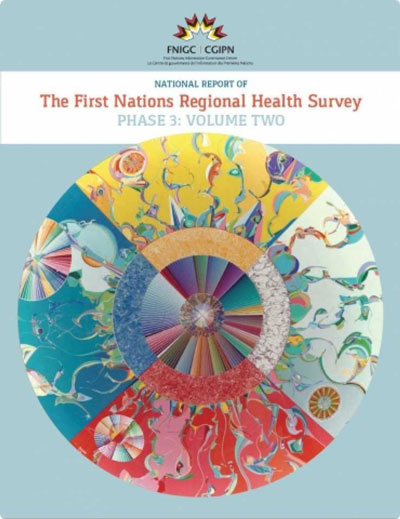The second volume of the National Report of the First Nations Regional Health Survey Phase 3, released today by the First Nations Information Governance Centre (FNIGC), provides unparalleled insight into a wide array of factors, from language and culture to health-care access and food security, that affect the health and well-being of First Nations people living on reserve and Northern communities across Canada.
This final volume, which marks the conclusion of a landmark five-year survey process conducted by FNIGC and its Regional Partners across the country, explores national RHS Phase 3 data related to health-care access, language, culture, nutrition, food security, physical activity, and personal and community wellness. Among the RHS Phase 3 Volume Two’s key findings are:
- Most First Nations youth and adults have a strong sense of belonging and safety in their community. The majority of First Nations adults (80.6%) rated their sense of community belonging as somewhat or very strong, while 81.5% adults reported feeling reasonably or very safe in their community. More than three-quarters (76.6%) of First Nations youth reported a somewhat or very strong sense of belonging to their community, and 83.2% of youth felt very or reasonably safe in their community.
- First Nations children have a strong connection to culture. More than one quarter (26.2%) of First Nations children report that they always or almost always participate in their community’s cultural events, and nearly half (45.2%) reported that they sometimes participated.
- First Nations youth are experiencing significantly higher rates of bullying. More than 1 in 4 (27.9%) of First Nations youth had experienced bullying in the RHS Phase 3, compared to 1 in 10 (11.7%) in the RHS Phase 2 (2008-2010).
- Access to primary health care remains an issue in First Nations communities. More than 1 in 5 (21.3%) First Nations adults reported not having a primary health-care provider, compared to 15.8% among the general population.
- First Nations women (youth and adults) have significantly higher rates of suicidal thoughts and suicide attempts compared to First Nations men (youth and adults). Female adults reported higher percentages of lifetime suicidal thoughts (18.7%) compared with male adults (13.7%); and nearly twice as many female adults (14.3%) as male adults (8.2%) reported a suicide attempts in their lifetime. Female youth (aged 12-17) reported significantly higher percentages of lifetime suicidal thoughts (23.1%) compared with male youth (9.3%); and three times as many female youth reported suicide attempts in their lifetime (15.6%), compared with male youth (5.2%).
- Food insecurity continues to be an alarming and urgent health issue in First Nations communities. While half (49.2%) of First Nations households were categorized as food secure, more than one-third (37.7%) of households were moderately food insecure, and more than 1 in 10 (13.1%) were severely food insecure. (This represents only a slight decrease from the RHS Phase 2, which showed that 45.7% of households were food secure, 38.3% were moderately food insecure, and 14.1% were severely food insecure).
“The results from the second volume of this essential First Nations-led report reveal some of the strengths, challenges, and resiliencies of our First Nations communities across the country, while also challenging a lot of common assumptions and misconceptions,” says Dr. Jonathan Dewar, Executive Director of FNIGC.
“It’s my hope that the information contained in the RHS Phase 3 report will serve to inform decision-making at all levels of government, as well as contribute to a richer body of knowledge about the ever-changing nature of life in First Nations communities, for researchers, policy makers, politicians, media, and the general public.”
The RHS was the first—and is still the only—national health survey created, conducted, and carried out by First Nations people for First Nations people. Launched in 1997, the RHS is rooted in Traditional and Western understandings of health and well-being and gathers information in First Nations reserve and northern communities across Canada.
RHS Phase 3, the latest phase of the survey, began data collection in April 2015 and wrapped up 18 months later finishing with 23,764 surveys completed in 253 First Nations communities, or 78 percent of its target number—a highly successful response rate for a survey of this size and complexity. The results of the second volume of the RHS Phase 3 are contained in the National Report of The First Nations Regional Health Survey Phase 3: Volume Two, which was released today during the Assembly of First Nations’ Annual General Assembly in Vancouver, British Columbia.
Copies of the 168-page report can be downloaded from our Online Library or by visiting FNIGC’s booth (#261) at the Circle of Trade at the Vancouver Convention Centre East, 999 Canada Place, as part of the Assembly of First Nations’ 39th Annual General Assembly.
FNIGC is an incorporated non-profit organization operating with a special mandate from the Assembly of First Nations Special Chiefs in Assembly (Resolution #48/2009). First Nations-led, FNIGC envisions that every First Nation will achieve data sovereignty in alignment with its distinct worldview.
Media: Brad Mackay 613-314-2575 or [email protected]
